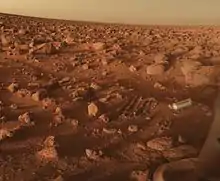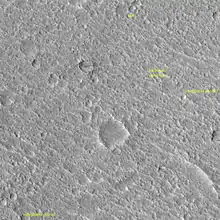List of artificial objects on Mars
The following table is a partial list of artificial objects on the surface of Mars, consisting of spacecraft which were launched from Earth. Most are defunct after having served their purpose, but the Curiosity rover and the InSight lander are still operational as of 2019. InSight is the most recent artificial object to land safely on Mars. The table does not include smaller objects, such as springs, fragments, parachutes and heat shields. As of November 5, 2016, there are about 14 spacecraft missions on the surface of Mars: some of these missions have multiple spacecraft.
Legend
| Colors | |
|---|---|
| No data collection | |
| Transmitted data | |
| Operational | |
Table of objects
In this listing, it is implied that each mission left debris according to its design. For example, the Schiaparelli EDM lander likely exploded on impact, creating an unknown number of fragments at one location. At another location, there may be a lower heat shield, and at another location, a parachute and upper heat shield. Another example is the counterweights ejected by MSL during its descent. In some cases, the nature and location of this additional debris has been determined and, in other cases, even the location of the main spacecraft has remained unknown. The identification of Beagle 2 after 11 years is one of the greatest breakthroughs yet, since prior to that, it could not be confirmed what had happened.[2] Spacecraft that have not been precisely located include Mars 2, Mars 3, Mars 6, Mars Polar Lander, and the two Deep Space 2 probes.
| Artificial object | Image | Nationality | Landed | Mass (kg) | Status | Location |
|---|---|---|---|---|---|---|
| Mars 2 |  |
USSR | 1971 | 1210 | Failure during descent; crashed on surface | Estimated at 45°S 313°W[3] |
| Mars 3 |  |
USSR | 1971 | 1210 | Transmission failure 14.5 seconds after soft landing | Estimated at Sirenum Terra, 45°S 158°W[4] |
| Mars 6 | 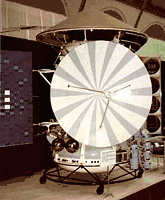 |
USSR | 1973 | 635 | Returned corrupted data for 224 seconds during its descent but contact lost before reaching surface[5] | Estimated at Margaritifer Terra, 23.90°S 19.42°W[6] |
| Viking 1 lander | 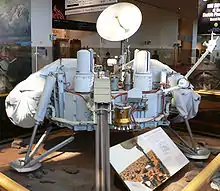 |
United States | 1976 | 657 | Operated 2245 sols. Last contact Nov 11, 1982 | Chryse Planitia, 22.697°N 48.222°W[7] |
| Viking 2 lander |  |
United States | 1976 | 657 | Operated 1281 sols. Last contact Apr 11, 1980 | Utopia Planitia, 48.269°N 225.990°W[8] |
| Mars Pathfinder lander and Sojourner rover |  |
United States | 1997 | 360 | Operated 83 sols. Last contact Sep 27, 1997[9] | Ares Vallis, 19.33°N 33.55°W[10][11] |
| Mars Climate Orbiter |  |
United States | 1999 | 629 | Destroyed by atmospheric stresses & friction.[12] | Unknown |
| Mars Polar Lander and Deep Space 2 |  |
United States | 1999 | 500 | Unknown failure during descent; crashed on surface | Estimated at Ultimi Scopuli, 76°S 195°W[13][14] |
| Beagle 2 |  |
United Kingdom | 2003 | 33.2 | Landed safely; solar panels failed to deploy | Isidis Planitia, 11.5265°N 90.4295°E |
| Spirit rover (MER-A) |  |
United States | 2004 | 185 | Operated 2210 sols. Last contact Mar 22, 2010 | Gusev crater, 14.5718°S 175.4785°E[15][16] |
| Opportunity rover (MER-B) |  |
United States | 2004 | 185 | Operated 5111 sols. Last contact June 10, 2018 | Meridiani Planum, 1.9462°S 354.4734°E[17][18] |
| Phoenix Mars Lander | 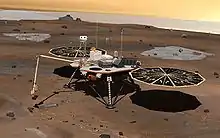 |
United States | 2008 | 350 | Operated 155 sols. Last contact Nov 2, 2008 | Vastitas Borealis, unofficially named Green Valley, 68.15°N 125.9°W[19] |
| Mars Science Laboratory (Curiosity) | United States | 2012 | 900 | Still in operation, 3021 sols | Aeolis Palus in Gale Crater, 4°36′0″S 137°12′0″E | |
| Schiaparelli EDM lander |  |
Europe (ESA) Russia (Roscosmos) |
2016 | 577 | Crashed on impact; transmitted descent telemetry | Meridiani Planum, 2°3′17″S 6°12′48″W |
| InSight lander | United States | 2018 | 358 | Still in operation, 780 sols | Elysium Planitia[20][21] 4.5°N 135.0°E | |
| Total estimated mass (kg) | 10,240 | |||||
- Orbiters whose orbit could eventually decay and impact the surface, include: Viking 1 and Viking 2 orbiters, MRO, 2001 Mars Odyssey, Mars Express, Mars Global Surveyor, Phobos 2, Mars 2, Mars 3, and Mars 5 orbiters, and Mariner 9. (See also List of Mars orbiters.)
- Mariner 9, which entered Mars orbit in 1971, is expected to remain in orbit until approximately 2022, when the spacecraft is projected to enter the Martian atmosphere and either burn up or crash into the planet's surface.[22]
Examples (surface)
 MER-A Spirit rover lander |
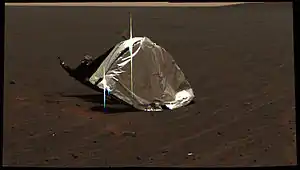 MER-B Opportunity's heat shield |
 MSL Curiosity self-portrait, 2016 |
From orbit
 Viking 1 lander in 2006 (HiRise) |
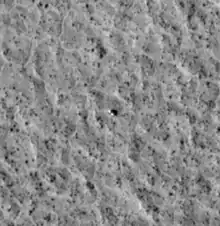 Viking 2 lander in 2006 (HiRise) |
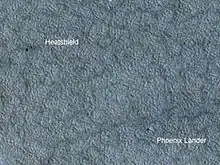 Phoenix lander and heat-shield in 2009 (HiRise) |
|
 MER-B Opportunity lander in Eagle crater (2006) |
 Beagle 2, after 11 years found and showing that it made it to the surface but did not expand fully to transmit |
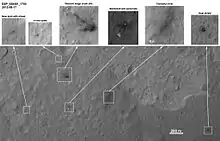 Curiosity landing remnants |
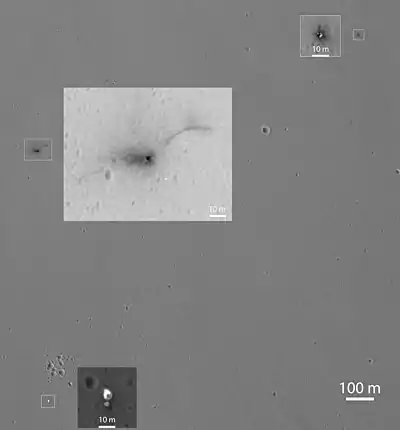 Schiaparelli remnants (2016) |
Landing site namings and memorials
Several landing sites have been named, either the spacecraft itself or the landing site:
- Pennants of Soviet Union on Mars 2 and Mars 3 landers (1971).[23]
- Thomas Mutch Memorial Station, the Viking 1 lander (1976).[24]
- Gerald Soffen Memorial Station, the Viking 2 lander (1976).[25]
- Carl Sagan Memorial Station, Mars Pathfinder (Sojourner) base (1997).[26]
- Challenger Memorial Station, MER-B (Opportunity) landing site area (2004).[27]
- Columbia Memorial Station, MER-A (Spirit) landing site area (2004).[28]
- Green Valley, the Phoenix lander (2008).
- Bradbury Landing, Curiosity rover landing site (August 6, 2012).[29] (Note: Due to the nature of the landing system, there is no actual space hardware at the touchdown location of Bradbury Landing, see Curiosity (rover))
- InSight Landing, the InSight lander (2018).
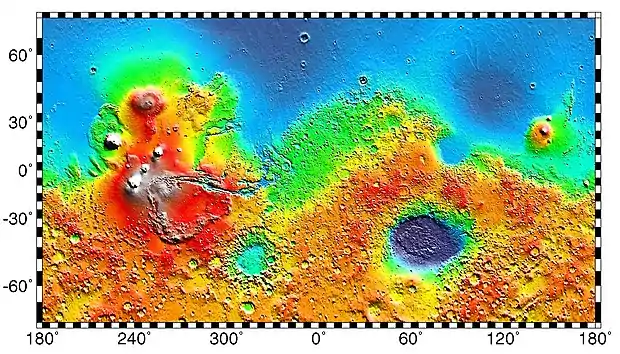
See also
References
- "NASA NSSDC Master Catalog - Mars 2". Retrieved 2010-12-24.
- "NASA NSSDC Master Catalog - Mars 3". Retrieved 2010-12-24.
- "NASA NSSDC Master Catalog - Mars 6". Retrieved 2010-12-24.
- "NASA NSSDC Master Catalog - Viking 1 lander". Retrieved 2010-12-24.
- "NASA NSSDC Master Catalog - Viking 2 lander". Retrieved 2010-12-24.
- "Mars Pathfinder". Retrieved 2011-12-07.
- "NASA NSSDC Master Catalog - Mars Pathfinder". Retrieved 2010-12-24.
- "NASA NSSDC Master Catalog - Mars Pathfinder Rover". Retrieved 2010-12-24.
- "NASA NSSDC Master Catalog - Mars Climate Orbiter". Retrieved 2010-12-24.
- "NASA NSSDC Master Catalog - Mars Polar Lander". Retrieved 2010-12-24.
- "NASA NSSDC Master Catalog - Deep Space 2". Retrieved 2010-12-24.
- "NASA NSSDC Master Catalog - Spirit Rover (MER-A)". Retrieved 2010-12-24.
- "ESA Mars Express - Spirit Rover landing site image and coordinates". Retrieved 2010-12-24.
- "NASA NSSDC Master Catalog - Opportunity Rover (MER-B)". Retrieved 2010-12-24.
- Squyres, S. W.; Arvidson, R. E.; Bollen, D.; Bell, J. F.; Brückner, J.; Cabrol, N. A.; Calvin, W. M.; Carr, M. H.; Christensen, P. R.; Clark, B. C.; Crumpler, L.; Des Marais, D. J.; d'Uston, C.; Economou, T.; Farmer, J.; Farrand, W. H.; Folkner, W.; Gellert, R.; Glotch, T. D.; Golombek, M.; Gorevan, S.; Grant, J. A.; Greeley, R.; Grotzinger, J.; Herkenhoff, K. E.; Hviid, S.; Johnson, J. R.; Klingelhöfer, G.; Knoll, A. H.; et al. (2006). "Overview of the Opportunity Mars Exploration Rover Mission to Meridiani Planum: Eagle Crater to Purgatory Ripple" (PDF). Journal of Geophysical Research. 111. Bibcode:2006JGRE..11112S12S. doi:10.1029/2006JE002771. E12S12. Archived from the original (PDF) on 2012-03-19. Retrieved 2010-12-24. Opportunity Rover (MER-B) coordinates on pg. 2.
- "NASA NSSDC Master Catalog - Phoenix Mars Lander". Retrieved 2010-12-24.
- "NASA Evaluates Four Candidate Sites for 2016 Mars Mission". NASA. 4 September 2013. Retrieved 4 September 2013.
- "Single Site on Mars Advanced for 2016 NASA Lander". NASA. 4 March 2015. Retrieved 16 December 2015.
- NASA - This Month in NASA History: Mariner 9, November 29, 2011 – Vol. 4, Issue 9 Archived May 14, 2013, at the Wayback Machine
- Soviet Craft - Mars (1960-1974) Archived 2013-07-08 at the Wayback Machine
- NSSDC - Viking 1 lander
- NSSDC - Viking 2 lander
- NSSDC - Mars Pathfinder
- NASA - Space Shuttle Challenger Crew Memorialized on Mars
- NASA - Space Shuttle Columbia Crew Memorialized on Mars
- "Curiosity Landing Site Named for Ray Bradbury". NASA. August 22, 2012. Retrieved August 24, 2012.

